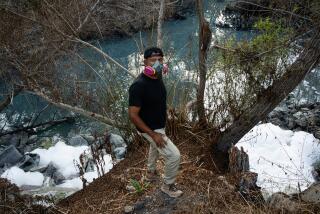Navy: Vials Probably From Military
- Share via
The Navy agreed Wednesday that the vials that washed up on Orange County beaches earlier this week are probably military equipment, but their specific source remained a mystery.
The vials were identified Tuesday as antiseptics that can be used as a defense in case of biological or chemical warfare, but health officials could not then confirm that the devices came from the military.
About 70 of the vials washed up on a 30-mile stretch of Orange County beaches on Monday and Tuesday.
The exact source of the vials has not been identified, according to John J. Hills, program manager for the Orange County Environmental Health Waste Management Section. He said that state and county environmental officials now must wait while military investigators try to track down the source.
“The military seems very interested in this, and the continuing investigation is being pursued by the military,” Hills said. “They are trying to find out who dumped these vials at sea and whether Navy rules against dumping closer than 50 miles from shore were violated. In the meantime, we’re conferring with the (Orange County) district attorney’s office to see if there is anything that we need to do.”
Hills said no more vials washed ashore in Orange County on Wednesday “that we know of.” Persons finding vials on the beaches should immediately turn them over to local police, Hills said.
A Navy spokesman in San Diego Wednesday acknowledged Hills’ statement that a special team had inspected the vials found in Orange County. But the spokesman, Navy Chief Craig Huebler, did not fully agree with Hills’ statement that the vials were definitely of military origin.
“We’re saying probably, “ Huebler said. “We’re saying there’s a good possibility that they came from the military supply system.”
Huebler said the Navy can’t necessarily be blamed for the dumping. He pointed out that other branches of the armed services, including the Coast Guard, operate at sea. “There are also contract ships that could have carried this,” Huebler said. “There is no evidence it came from a Navy ship.”
The Navy has also disclaimed responsibility for medical waste that washed up this week on San Diego County beaches. Huebler said that virtually all of the discarded medical supply items found on San Diego shores “could have come from anywhere,” adding that no specific military designations were found on the debris.
Huebler did acknowledge that one piece of debris this week has definitely been linked to a Navy ship, the Missouri. That item, he said, was an empty can of oxalic acid, a chemical used to clean the wooden decks of the historic battleship. The empty can was found on a beach in La Jolla.
“We have determined the U.S.S. Missouri was the user, but not that it was a violator,” Huebler said. He added that the label was still on the can, indicating that it had not been in the water very long. It is possible that someone on shore threw the empty can into the sea, he theorized.
The Navy also has denied any connection with medical flotsam that drifted onto beaches in Oregon this week.
On Monday, unopened bottles of medical supplies, including denatured alcohol and powdered Novocain, washed up on a 40-mile stretch of beaches in Tillamook County in northern Oregon. Environmental officials in that state said Wednesday that evidence indicates a ship fairly close to shore dumped the material, but the specific ship has not been identified.
Carolyn Young, spokeswoman for the Oregon Department of Environmental Quality, said in a telephone interview that there is no clear indication that the debris came from a military ship. “We feel certain it came from a ship, but we don’t know what type,” she said. “It was probably close to shore or else the stuff would have scattered over a larger area.”
News accounts of the latest vials incident prompted one boating enthusiast to complain that the Navy was using the sea as a “sewer” for sailing ships.
Eric Lindholm, a Los Angeles attorney, said Wednesday that he was angered in late September when he saw Navy ships dumping “miles of garbage” in the ocean off San Diego. Lindholm recounted that he and his father, Thomas, also a Los Angeles attorney, witnessed a Navy ship dumping garbage “about 35 to 40 miles offshore, just above the Mexican border.”
“I was infuriated,” said Lindholm, who called a reporter to describe the incident. “There was bag after bag of garbage being dumped for about 2 miles. My father got on the radio and protested to the ships.”
Huebler, the Navy spokesman, said Wednesday that he knows of no evidence ever presented that a Navy ship has dumped garbage closer than 50 miles to shore. “Other ships only observe a 3-mile limit, but the Navy does not dump within 50 miles, and we have not been found responsible for any dumping within those limits.”
In Orange County, meanwhile, county environmental health officials said a major problem they face is trying to get federal officials to police ocean dumping. They said that while state law provides fines for ocean dumping, the law is difficult to enforce beyond the shore.
“We’re not even sure how the (state) law applies (to ocean dumping) in some cases,” Hills said.
Chart gives some data on hospital waste, Life,Page 2
More to Read
Sign up for Essential California
The most important California stories and recommendations in your inbox every morning.
You may occasionally receive promotional content from the Los Angeles Times.










